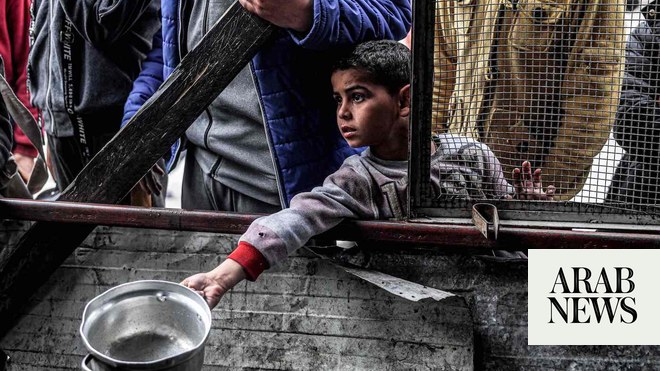Famine imminent in northern Gaza: report

[ad_1]
ROME: Famine was imminent in the northern part of the Gaza Strip and the entire population there was facing crisis levels of food insecurity or worse, according to a report released on Monday.
In Gaza’s two northern governorates, where around 300,000 people remain trapped, famine was expected to arrive anytime between now and May, the new Integrated Food Security Phase Classification report revealed.
The famine threshold for acute food insecurity had already been far exceeded, while acute malnutrition among children aged under five was proceeding at record pace toward a second famine threshold.
Non-trauma mortality — the final famine indicator — was accelerating too, but data remained limited, as was typical in war zones.
Overall, the new report showed that 1.1 million people in Gaza — half of the population — had completely exhausted their food supplies and coping capacities and were struggling with catastrophic hunger (IPC Phase 5) and starvation.
This was the highest number of people ever recorded as facing catastrophic hunger by the IPC system and double the number in IPC Phase 5 just three months ago.
UN World Food Programme Executive Director Cindy McCain said: “People in Gaza are starving to death right now. The speed at which this man-made hunger and malnutrition crisis has ripped through Gaza is terrifying.
“There is a very small window left to prevent an outright famine and to do that we need immediate and full access to the north. If we wait until famine has been declared, it’s too late. Thousands more will be dead.”
The report noted a steeply increasing trend in malnutrition across the Strip, where acute malnutrition stood at less than 1 percent before the escalation in fighting five months ago.
In the North Gaza governorate, the latest data indicated that one in three children below the age of two was now acutely malnourished or “wasted.” This meant they were dangerously thin for their height, which puts them at risk of death.
The southern governorates of Deir Al-Balah, Khan Younis, and Rafah, are classified in IPC phase 4 (emergency) and also risked slipping into famine conditions by July.
Throughout Gaza, 88 percent of the population faced emergency or worse food insecurity.
The report said that famine — even in northern Gaza — can be halted if full access was facilitated for aid organizations to provide food, water, nutrition products, medicines, health, and sanitation services, at scale, to the entire civilian population. For this to be possible, a humanitarian ceasefire was necessary.
World Food Programme officials estimate that simply addressing the basic food needs would require at least 300 trucks to enter Gaza every day and distribute food, especially in the north. The WFP has only managed to take nine convoys to the north since the start of the year.
The latest of these, on Sunday night, involved 18 truckloads of food supplies delivered by WFP to Gaza City. The convoy, the second to use a coordinated route into Gaza City and the north, delivered 274 tonnes of wheat flour, food parcels, and ready-to-eat rations. The route needed to be made available for daily convoys and safe access to the north.
Dispatching aid to the north of Gaza requires day-to-day approvals from Israeli authorities. During the long waits at the Wadi Gaza checkpoint, truck convoys face looting and are frequently turned back. If they do get through, there is a high risk of more looting along the difficult route north.
WFP Deputy Executive Director and Chief Operating Officer Carl Skau said: “WFP and our partners have food supplies ready, at the border and in the region, to feed all 2.2 million people across Gaza — but moving food into and within Gaza is like trying to navigate a maze, with obstacles at every turn.
“The complicated border controls, combined with the high tensions and desperation inside Gaza, make it nearly impossible for food supplies to reach people in need, particularly in the north. But the delivery of 18 trucks of food on Sunday shows that it can be done.
“This cannot be a one-off, but this needs to be sustained, regular and at scale to support those in need.”
To provide the necessary response, WFP and its humanitarian partners need Israel to provide more entry points into Gaza, direct access via crossings in the north, and the use of Ashdod port in Israel to bring in food aid.
Sustained road access — both into Gaza and then within Gaza — was critical because other options, such as airdrops, could not deliver the volume of aid urgently needed to avert imminent famine. Above all, a ceasefire was urgently needed for WFP and the humanitarian community to roll out a massive relief operation reaching all the communities in need.
[ad_2]
Source: Arab News




